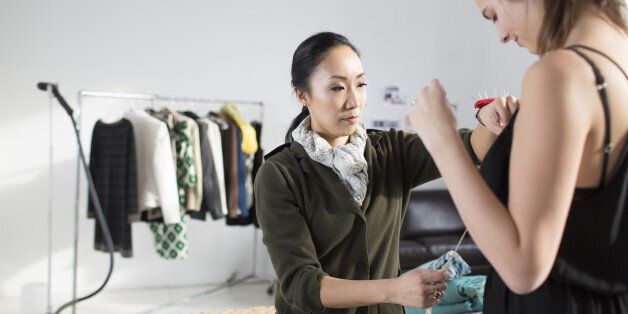

Hands up if you have recently made an instantaneous clothing purchase to find that you don't actually love the item when you get round to wearing it a couple of times?
I know I am not alone, the UK sends over a million tonnes of clothing to landfill sites a year.
Two years ago I used to regularly buy a cheap fashion dress because it was part of the latest trend and I thought I would look amazing in it, only to wear it once then hide it at the back of my closet.
Flash forward to today, and I have worked hard to ensure that each and every piece in my wardrobe has been carefully curated and selected to reflect my own personal style. This way my closet is filled with quality investment pieces I know I will wear time and time again.
My personal style can be defined as Vintage & Safe Neutrals. I like delicate neutral clothing, in more traditional cuts, which often have a vintage feel about them.
My clothing colours tend to be black, navy or grey and I have a lot of silk and wool items. You can see some of the looks over on my Instagram.

But why have I done this, and how do I know this?
Well for starters, I currently take part in Project 333 which you can read about here. Living with a capsule wardrobe means I need to love every item I have or I wouldn't wear anything. This means I need to know what my personal style is. What suits me. What looks good.
How can you refine your own personal style?
Step One: Declutter
You want to begin in a good place, and therefore you need to avoid sorting through clothes that don't have a place in your closet.
Take two boxes upstairs, one for recycling and one for donating.
If it is broken or stained you need to recycle it. If you haven't worn it in over a year consider donating it. If you still love it, keep it.
Oh and please, please don't keep the just in cases. The 'just in case I lose a stone, the just in case I need to do some DIY' It is an easy clutter filled trap to fall into.
I know some people follow this process of removing and reducing to clear space, only to begin collecting again until you need to repeat the decluttering down the line.
I see a minimalist defined wardrobe as a way of removing the waste once, and then shopping smartly going forward to ensure that clutter never collects again.
Step Two: A week of clothes
Go into your closet, wardrobe or drawers and pick out your favourite items (no more than 12) that you wear regularly and can be easily mixed and matched.
For the next week, I want you to wear these items and these items only.
Whilst doing so, ask yourself:
- What do these items all have in common? Are they a similar fabric, shape or colour?
- Are they practical and is this why you wear them so regularly?
- How did you obtain these pieces? Were they investments or did you just happen across them and buy them almost instantaneously?
If you can, think of some key adjectives to describe what you've gathered to wear for the week.
When you have answered all of the above, you should have some key components already for what your personal style should look like. You can document this on the print out below if you want to.

Step Three: Favourite Items
Now go into your wardrobe again and pick out your three favourite items. The only rules here is that you need to have worn the items in the last six months. You might have more sentimental pieces, but right now we are looking for key influencers for your personal trend.
Define one reason why you love each item. Try to be specific. Is it the fit, the colour or the reason you own it?
Step Four: Put together your own defined personal style
From the above exercises, I want you to make a personal style guide that sums up your own personal style. Do this in whatever form you think works best for you. Paint the colour palette, make a mood board, or use the chart below. The world is your oyster.

By only buying from these guidelines, your wardrobe will reflect what styles, shapes and colours suit you best.
This means that you no longer need to waste precious time and money on those instant gratification buys, and can instead invest your earnings into something that enriches your life.
Make investment purchases which look great on you, and forget about fast-fashion trends.
This September The Huffington Post UK Style is focusing on all things sustainable, for the second year running. Our thirst for fast fashion is dramatically impacting the environment and the lives of thousands of workers in a negative way. Our aim is to raise awareness of this zeitgeist issue and champion brands and people working to make the fashion industry a more ethical place.
We'll be sharing stories and blogs with the hashtag #SustainableFashion and we'd like you to do the same. If you'd like to use our blogging platform to share your story, email ukblogteam@huffingtonpost.com
